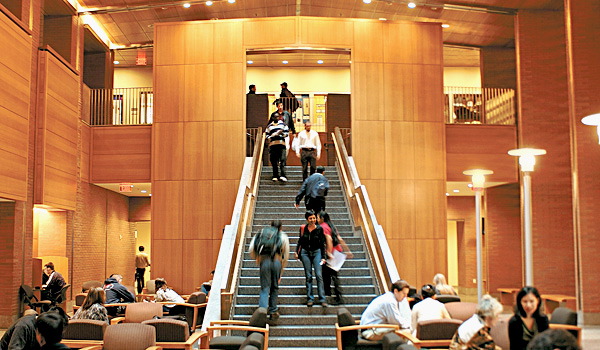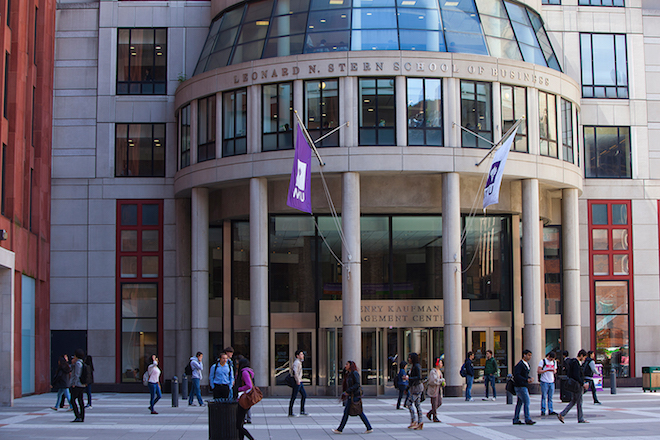Wharton School
It’s hard not to watch Wharton. Last year, the proverbial favorite finished 2nd to Washington University for top honors in P&Q’s inaugural undergraduate business school ranking. However, Wharton couldn’t be denied in 2017, ranking first in undergrad rankings with both P&Q and U.S. News.
With the former, the contest really wasn’t even close. As a whole, Wharton ranked first in the quantitative and survey data sets related to admissions and employment – and second for academic experience. With U.S. News, Wharton dominated academically, ranking as the top program in finance, marketing, real estate, and insurance (and finishing second in management, international business, and operations). Dominant? You don’t say.
What makes Wharton the best is hardly a secret. On the surface, a hall of fame faculty and a wealth of resources and options separates it from most rivals. Boil it down further and the differentiator comes from keeping things simple. “I think our Dean Geoff Garrett says it best: ‘We do the right things for our students and the rankings will take care of themselves,” says Lori Rosenkopf, the vice dean and director of Wharton’s undergraduate program. “We really focus on the fundamentals in educating our students.”
What does that mean exactly? That depends on the student. When P&Q surveyed the Class of 2015, one student wrote about enjoying how he helped professors with research. Another gushed about how he was able to run his own project for a year without someone constantly looking over his shoulder. A third talked about how a business simulation built a sense of camaraderie with peers – and helped reinforce investment and operational strategies in the process.
“So much of my Wharton experience shaped me and helped me develop both at a professional and a personal level,” writes another graduate. “For instance, most of our business classes had group projects that dealt with real-world issues, some of which even required us to report to actual clients. In one of my classes, we had to develop a strategy for JCPenney and at the end we presented to the company’s marketing directors. It was an incredible experience which definitely prepared me for life after college.”
Wharton may possess the best brand name in undergrad business education, but the school is hardly afraid to tinker with their formula. Long regaled for teaching “technical fundamentals,” Wharton recently revamped its four year curriculum to complement its strengths. For one, it built more “flex fundamentals” into its courses to further expose students to the applications and impact of globalization. In addition, it has incorporated a “Leadership Journey” that addresses a particular theme during each year of study. As freshmen, business majors take a course on building self-awareness. During sophomore year, business communications is covered. During their third year, teamwork and interpersonal relationships are studied and practiced before seniors complete a capstone project that ties the journey together.
“’Business and More’ is our tagline,” Rosenkopf adds. “It’s the fact that not only do you get a great business education here, but you’re studying at an Ivy, you’re studying at Penn, and you have the opportunity to get a great liberal arts education along the way. All those things together, it’s an awesome place. Why wouldn’t a student want to come here?”
The answer may come in the form of Wharton’s student body. Last year, Wharton accepted just 7.1% applications to the undergraduate business program, making it one of the most exclusive anywhere. Students arrive with a 1499 SAT on average, with 93.8% of the class graduating in the top 10% of their high school class. Wharton classes also tend to be very diverse. Nearly 23% hail from overseas, with another 20% comprised of U.S. minorities. First-generation college students take up another 12% of the class.
Not surprisingly, these students are coveted by employers. Ninety-nine percent of all 2016 Wharton grads received internships, including one recent intern who pulled down $25,000 a month. Another 98% landed jobs within three months of graduation. Between base and bonus, Wharton grads started at $90,601 in 2016, up $3,600 from the previous year. With outcomes like these, graduates are thrilled with their choices. In P&Q’s 2017 alumni survey, 100% answered that they were working in their desired industry.
It wasn’t just the outcomes where Wharton earned kudos. In the same survey, Wharton scored higher than all comers in the quality of the alumni network – and performed nearly as well in everything from extracurricular activities to workplace preparation to overall experience. Bottom line: Wharton sets the bar in undergraduate business education. That makes them a target. However, it also makes them the school to watch – and emulate.
New York University (Stern)
New York City is the center of the universe. Don’t believe me? Just ask a New Yorker.
There is something for everyone in the Big Apple. Shadowed beneath the iconic skyline, you’ll find Wall Street for high rolling bankers, Broadway for idealistic triple threats, Madison Avenue for shape-shifting advertisers and 5th Avenue for glossy fashionistas. It is the home of mass media and publishing, high art and culture, and (increasingly) tech firms and startups. It remains the world’s melting pot, filled with people from every nationality and background – all looking to starting over and find a purpose.
Sounds like the perfect place for a business school, right? That’s just one advantage to the Stern School of Business, one of the largest American business programs with over 2,600 students. That doesn’t even factor in the nearly 50,000 alumni in the New York area! In this program – surrounded by countless industries and experts – students’ biggest obstacle may be finding the time to pursue everything that excites them.
By the numbers, it was a good year to be a Stern grad. In the 2017 P&Q ranking, Stern crashed into the Top 10 at 8th, buoyed by strong admissions and employment outcomes. Notably, the school maintained a stringent 11% acceptance rate coupled with a formidable average SAT (1468). In addition, nearly three-quarters of students rank among the 10% of their high school class.
Such credentials – coupled with a myriad of opportunities in New York – enabled 98% of the 2017 class to complete internships during their four years. Such success also led to a 97% placement rate for Stern grads last year at $78,349 when base and bonus are counted together, ranking it among the top five programs for pay. Better yet, most students can start cashing those checks immediately. Just a third of business graduates carry debt – at an average just under $25,000 no less.
One of the school’s most unique features is its global immersion program. A semester-long required course, juniors complete field studies overseas to gain a deeper understanding of globalization and differing business cultures and economic systems. In a world gone global, Stern’s International Studies Program offers graduates a decided edge in the marketplace. The same is true of global exchange programs, where an impressive 56% of graduates spend a semester studying abroad.
Beyond that, the school’s sheer scope makes it a program to watch. Home to over 200 faculty members, Stern is able to offer signature programs like luxury marketing, politics, and social impact that may only be covered in one course in other business schools. This breadth of experience only enriches their four years at Stern.
“The school made a concerted effort in create experiences in which we learned through doing: traveling, presenting, listening to world-class speakers, etc,” notes one 2015 graduate. “There was never a point at which I felt that the learning was too classroom oriented. From freshman year through graduation, we were engaged in group work, cultural immersion, and other forms of learning outside of the classroom.”













Questions about this article? Email us or leave a comment below.